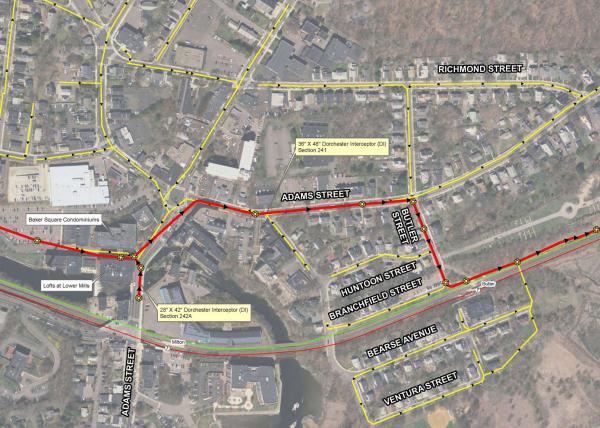September 18, 2018

A segment of a map prepared by the engineering firm CDM Smith for the MWRA shows the route of the Dorchester interceptor pipe in red. Download a larger version below.
A one-year project to modernize a key underground sewer line will impact traffic on several streets in and around Lower Mills and Cedar Grove starting next spring. Officials from Massachusetts Water Resources Authority will brief neighbors about the planned $6.2 million project at Tuesday evening’s Lower Mills Civic Association meeting (7 p.m., St. Gregory’s auditorium.)
The sewer line— known as the Dorchester Interceptor —carries waste from Mattapan, Milton, and Dorchester to another line that then pumps it to Deer Island, where the region’s sewage is treated. The brick pipe was built in 1895 and is broken in several places along its route from Central Avenue in Milton to Granite Avenue, where it connects with another sewer main.
John Colbert, interim chief engineer for MWRA, said that the original builders of the pipe could pride themselves on “outstanding craftmanship.” Still, at 120 years old, “we have leakage into the pipe and some [tree] root intrusion,” said Colbert.
The project will not require a full replacement of the whole 6,500-foot-long pipe, which is good news— since that would require large-scale excavation of several key arteries— including Adams Street. Instead, workers will be able to insert a “liner” pipe inside the old 28 x 32-inch, egg-shaped brick structure and will use “trenchless methods to minimize surface disturbances along the sewer and keep traffic and access impacts to a minimum.”
The sewer pipe winds its way from Central Ave to Lower Mills village through the footprint of the old Walter Baker Chocolate property. It runs under the roadway up Adams Street to Butler Street, where it turns right and follows a route into the Neponset River reservation along the Neponset River Greenway on the “southern limits of the Cedar Grove Cemetery” to Granite Avenue. “The sewer crosses Granite Avenue north of the bridge and continues a short distance eastward onto riverside parklands,” according to the MWRA project description.
Pits to access the pipe will be existing manhole locations along much of the route at an interval of roughly 600 to 800 feet to insert the new pipe.
“There shouldn’t be any interruption in [sewer] service to individual homes,” said Jeff McLaughlin, the director of public affairs for the MWRA, who will lead the Tuesday evening briefing.
One tricky construction spot that will likely cause some lane restrictions during a portion of the project is the Adams Street-Dorchester Avenue intersection, in front of Dunkin Donuts, McLaughlin said.
“The interceptor is right in the middle of the street at that spot,” he said. The agency will coordinate with Boston Transportation Department as the project design is finalized to plan out lane restrictions. The project is now at 90 percent design and has not yet been put out for contractor bids.
A temporary, above-ground bypass pipe will be installed as the project begins to divert waste out of the interceptor. Colbert said that the 12-inch pipe will be run along the Greenway route from Central Avenue to Granite Avenue, with two pumping stations set up in the Rite Aid parking lot at Central and near Butler Street trolley station as part of the project.
Villages:
| Attachment | Size |
|---|---|
| 703.05 KB |


